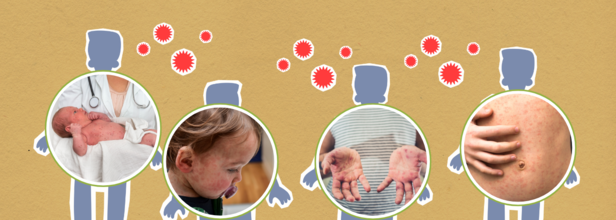- Health Conditions A-Z
- Health & Wellness
- Nutrition
- Fitness
- Health News
- Ayurveda
- Videos
- Medicine A-Z
- Parenting
- Web Stories
Even After The Elimination Of Measles In 2000, Why Is US Struggling With It Today?

Credits: Canva
The United States is facing its worst measles outbreak in 25 years, with more than 1,270 confirmed cases reported so far this year—surpassing the previous high of 1,274 cases in 2019. The data, compiled by Johns Hopkins University, has raised alarms among health officials, who believe the actual number of infections may be even higher due to underreporting.
Tragically, three people have died from the virus this year—two children in Texas and one adult in New Mexico. All of them were unvaccinated.
“This move will further fuel the spread of vaccine-preventable illnesses,” said Dr. Bruce A. Scott, president of the American Medical Association, referencing ongoing declines in vaccination rates and policy shifts that threaten public health.
From Elimination to Outbreak
Measles is one of the most contagious diseases known and was declared eliminated in the United States in 2000, thanks to the widespread use of the MMR (measles, mumps, rubella) vaccine. However, current outbreaks suggest a reversal of that progress.
The largest outbreak this year began in January in Gaines County, West Texas—a region with one of the lowest vaccination rates in the state. So far, that outbreak alone has led to over 750 confirmed cases and has spread to neighboring areas in New Mexico and Oklahoma, with possible links to Kansas.
Shockingly, nearly one in four kindergartners in Gaines County did not receive their required MMR vaccine during the 2024–25 school year.
Spread Through Travel and Everyday Contact
Measles spreads easily through airborne droplets when an infected person coughs, sneezes, or talks. The virus can also live on surfaces like doorknobs for several hours, making it especially hard to contain.
Air travel has further complicated containment efforts. In Colorado, an out-of-state visitor unknowingly spread the virus while contagious, leading to multiple cases—including individuals who were only at the airport at the same time.
According to the CDC, nearly 1 in 8 people infected this year required hospitalization, and about 30% of all cases have been in children under the age of five. Most of these children were unvaccinated.
The Role of Vaccination
The MMR vaccine remains the most effective tool against measles. One dose offers 93% protection, while two doses provide 97% protection.
In response to the crisis, some states have taken emergency steps to protect infants. Several have lowered the age for the first MMR shot from 12 months to 6 months. The results have been encouraging—early vaccination rates among 6-month-olds in Texas are now eight times higher than in 2019.
New Mexico has also seen a significant rise in vaccination, and both states are working hard to protect their most vulnerable populations.
Still, nationwide vaccination rates remain below targets. The U.S. aims for 95% of kindergartners to receive both doses of the MMR vaccine, but this benchmark has been missed for the past four years. In the 2023–24 school year alone, over 125,000 kindergartners lacked at least one required vaccine.
A Shifting Public Health Landscape
Public health experts are concerned that growing distrust in vaccines and leadership changes at the federal level may further undermine efforts to control the disease.
As of now, the CDC does not have a permanent director in place, and U.S. Health and Human Services Secretary Robert F. Kennedy Jr.—a long-time vaccine skeptic—has made controversial decisions. Though he recently expressed support for vaccines, his previous statements and the removal of key expert panels have left public health officials worried.
If outbreaks linked to the Texas region continue into 2026, the U.S. risks losing its measles elimination status. Experts say rebuilding public trust in vaccines and boosting routine childhood immunizations must become a national priority—before the disease becomes even harder to contain.
Robotic Joint Replacement Surgeries: How Health Insurance Can Partner In Expanding Access To Advanced Orthopaedic Care For Indian Patients?

Credits: Canva
India’s growing population, coupled with rising life expectancy and lifestyle-related factors, is driving a steady increase in joint-related orthopaedic conditions such as arthritis and degenerative joint disease. As a result, the demand for joint replacement surgeries has surged significantly. Today, total knee replacements alone have surged from approximately 100,000 five years ago to nearly 250,000 annually, reflecting both rising incidence and growing awareness of surgical solutions.
Robotic-assisted joint replacement is currently the most advanced and accurate form of surgery available. It enhances surgical precision, ensures better implant alignment, minimizes tissue damage, and allows for faster patient recovery. These clinical benefits are translating into measurable improvements in patient outcomes and satisfaction.
Yet, despite its many advantages, access to robotic-assisted joint replacement is still evolving, particularly when it comes to insurance coverage. While conventional joint replacement procedures are widely supported by most health insurance plans, coverage for robotic-assisted variants is still gaining traction. As the healthcare ecosystem adapts to newer technologies, there is an opportunity for insurers and providers to work together to bridge this gap, ensuring that patients who could benefit from these advanced, minimally invasive procedures are able to access them more easily.
India is witnessing a sharp uptick in the adoption of robotic surgery, with nearly 12,000 robotic- assisted procedures performed in 2022. While this marks encouraging progress, it still represents only a small fraction of the potential demand. By comparison, the United States conducted approximately 876,000 robotic surgeries in 2020 3 and has over 5,500 surgical robots installed for a population of around 330 million 4 . Given India’s population of over 1.4 billion and the growing burden of joint-related conditions, the need for wider deployment of robotic technology is clear. There is a significant opportunity and an urgent imperative to scale infrastructure, surgeon training, and insurance coverage to meet this rising demand and ensure equitable access to advanced care.
For patients, the advantages of robotic-assisted joint replacement surgeries are compelling and directly impact their journey to recovery and improved quality of life:
- Less tissue damage: reduced post-operative pain and a more comfortable recovery experience for the patient.
- Increased implant placement accuracy, reducing complications: Precision in implant placement minimizes the risk of complications, potentially preventing the need for revision surgeries and ensuring a longer-lasting solution for the patient.
- Improved mobility and quality of life in the immediate post-operative phase: Patients often experience quicker restoration of movement and a faster return to daily activities
- Shorter hospital stays and quicker recovery: less time away from home and work, reducing the financial and emotional burden on patients and their families.
These benefits are raising patient and healthcare provider awareness and demand, particularly for older people and those with conditions like arthritis. The deployment of robotic technology is expanding beyond renowned private hospitals to community health centres and smaller communities as its cost becomes more affordable, democratizing access to advanced medical care.
The Insurance Regulatory and Development Authority of India (IRDAI) has acknowledged robotic-assisted surgeries under its “Modern Treatment Techniques” category, a positive step toward broader integration. However, some variability in coverage still exists, with certain policies including sublimits or caps that may unintentionally limit patient access to these advanced procedures. As awareness and clinical evidence continue to grow, there is an opportunity for insurers to revisit these norms in partnership with healthcare providers to better align coverage with evolving standards of care.
By fostering dialogue and collaboration between insurers, regulators, and medical professionals, there is a shared opportunity to re-evaluate coverage policies in light of evolving clinical evidence and patient needs. Expanding coverage for robotic-assisted procedures is not just about technological advancement - it’s about enabling more patients to benefit from faster recovery, fewer complications, and improved quality of life.
Together, we can ensure that no patient is left behind due to coverage limitations. By aligning on the shared goal of improved outcomes, we can unlock the full potential of robotic-assisted joint replacement and contribute to a healthier, more resilient India.
Written by Dr. Jayant Arora – Senior Director & Unit Head, Orthopaedics, Fortis Hospital, Gurgaon
This Is How You Can Manage Your Blood Glucose Levels Amid Seasonal Changes

Credits: Canva
As the monsoon sets in with its comforting rains and cooler temperatures, it also brings along a host of health challenges—especially for those managing chronic conditions like diabetes. The high humidity and increased risk of infections during this season can throw blood sugar levels off track. This makes it essential for people with diabetes to adopt a well-rounded, preventive approach that goes beyond just medication.
The Monsoon Effect on Diabetic Health
The rainy season raises the likelihood of infections—ranging from seasonal flu to waterborne diseases—that can be more severe for individuals with diabetes.
A compromised immune system, often seen in those with poorly managed diabetes, means the body finds it harder to recover from even mild illnesses. This is why monsoon care calls for extra attention to immunity, hygiene, and consistent glucose management.
Immunity Begins in the Kitchen
Diet plays a key role in preventing seasonal infections and managing blood sugar. While fried snacks and street food can be hard to resist during rainy weather, they come with the risk of contamination and erratic blood sugar spikes.
Instead, stick to freshly cooked meals at home. Include immune-boosting ingredients like garlic, turmeric, ginger, and vitamin C-rich fruits such as oranges and guavas. Avoid raw salads and ensure that all vegetables are washed thoroughly and cooked properly.
Keep a Close Watch on Glucose Levels
Changes in routine, diet, and physical activity are common during the monsoon and can lead to sudden fluctuations in blood sugar. Even weather itself—specifically high humidity and temperature drops—can affect insulin absorption and sensitivity.
That’s where technology comes in. Continuous Glucose Monitoring (CGM) devices allow users to track their glucose levels in real-time, eliminating the need for frequent finger pricks. These wearables are especially handy when stepping out to a clinic may not be convenient or safe due to the weather.
Foot Care is Non-Negotiable
Wet feet are breeding grounds for fungal infections, something people with diabetes are particularly vulnerable to. Foot injuries can also take longer to heal, increasing the risk of complications.
Always dry your feet thoroughly after returning indoors, wear moisture-wicking socks, and avoid walking barefoot or in wet shoes. Invest in closed, comfortable footwear that protects your feet from puddles and muddy surfaces.
Don’t Let Fitness Slide
Rainy days often disrupt outdoor exercise routines. But staying active is critical for blood sugar control.
Adapt your workout by moving it indoors—simple home-based exercises, yoga, or even a walk around your living space can help keep glucose levels stable. Aim for at least 30 minutes of activity daily to support metabolic health.
Hydration is Key
Many people underestimate how easy it is to get dehydrated during the monsoon. High humidity can suppress thirst, but dehydration can directly impact glucose levels.
Make a conscious effort to drink plenty of water. Herbal teas and infused waters not only add flavor but also help in digestion and hydration.
Stay Alert to Warning Signs
The risk of both hyperglycemia and hypoglycemia can increase during the rainy season. It’s important to stay vigilant and recognize any symptoms of fluctuating sugar levels early—such as fatigue, dizziness, or confusion—and take corrective steps immediately. Keeping emergency snacks and medications within easy reach is a good habit to maintain.
UK Health Officials Issue A Public Warning And Safety Guidelines Against These Bugs That Cause Lyme Disease

(Credit-Canva)
As an unexpected wave of heat hits the UK, many people have been concerned regarding not just heat-illnesses, but also other issues that arise mostly in the summer season.
The UK Health Security Agency (UKHSA) has issued a public warning against a small, almost invisible threat that could send you to the hospital. Taking simple steps can help you avoid these bugs that could leave you with flu-like symptoms lasting for weeks.
The Hidden Danger: Ticks
Ticks are small bugs often found in woods, grassy areas, and moorlands. The reason why the volume of these bugs is more prevalent in these grassy areas is because it is easier to find and feed off other creatures there. These bugs are known to spread Lyme disease, a bacterial infection. You get it when a tick bites you and feeds on your blood, which can lead to flu-like symptoms. Not all ticks carry Lyme disease, though. It's usually easier to treat if caught early, but if it goes unnoticed, problems can worsen, causing joint pain, nerve issues, and memory problems.
Lyme Disease Treatment
The chances of getting sick are fairly low, as not all ticks carry the bacteria that cause Lyme disease. If you've been bitten, keep a close eye on the bite area for symptoms, especially the well-known "bullseye" rash. This rash can appear up to three months after a bite, but usually shows up within one to four weeks.
If a doctor thinks you might have Lyme disease, they'll prescribe antibiotics. The type you get depends on your symptoms, and you might need to take them for up to 28 days. It's very important to finish the entire course, even if you start feeling better. For severe symptoms, you might be sent to a hospital specialist to receive antibiotics directly into a vein.
A small number of people who are treated for Lyme disease continue to have symptoms like tiredness, aches, and low energy for years. These symptoms are often compared to conditions like fibromyalgia and chronic fatigue syndrome.
What to Do If You're Bitten
Tick bites might not hurt at first because ticks put a numbing substance into your skin, so you might not even notice you've been bitten. If you do find a tick, it's important to take it out the right way: use fine-tipped tweezers or a special tick-removal tool, grasp the tick as close to your skin as you can, and pull it slowly upwards without squeezing it. Never try to pull it out with your fingers, as this can leave part of the tick in your skin and cause an infection. After removing the tick, clean the bite area with antiseptic or soap and water.
Simple Prevention Tips
Health officials recently shared advice on how to protect yourself from these tiny parasites. They suggest simple actions are best to prevent tick bites:
- Regular checks are your best defense. While you're outside, brush off any ticks you spot right away.
- Do another check when you get home. Focus on exposed skin and any clothes where these bugs might be clinging.
- Don't forget to check children and pets, as they can't check themselves.
- Use an insect repellent that specifically prevents ticks.
- Wear long sleeves and long trousers when outdoors to reduce direct skin contact.
- When possible, stick to clearly marked paths and avoid brushing against plants where ticks might be hiding.
© 2024 Bennett, Coleman & Company Limited

